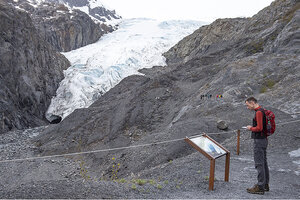Exit Glacier Exits - 3 Feet/Year Had Been Average Since 1815 - 300 Feet In 2016 Alone

?alias=standard_900x600nc
EDIT
In 2015, President Barack Obama stood at a lookout and enumerated the facts of glacial melting and rising sea levels. He stared into the distance then turned back to the cameras. “It is spectacular though,” he conceded, adding: “We want to make sure that our grandkids can see this.” I’m thinking more about my son, age 6. By the time he visits Alaska, the aptly named glacier – more on that name later – may have exited altogether. Exit, glacier. Curtain falls. Audience applauds. House lights go up.

?alias=standard_900x600
A marker shows how far Exit Glacier has receded since 2005. Photographed May 17 in Kenai Fjords National Park.
The retreat began in the 1800s when Alaska was still Russian territory. After five centuries of expansion during the period known as the Little Ice Age, Exit Glacier reached its maximum expanse around 1815. Since then it has been retreating, slowly at first, roughly 3 feet a year, based on soil and tree-ring analysis.
Now the glacier is retreating faster, much faster, in winter and summer. In 2016 it shrank by nearly 300 feet in a single year. The adjective glacial no longer applies, it seems. To walk the path to the lookout, then, is to tread a timeline of climate change, passing markers of the glacier’s historic extent. The marker for 1917 is about a mile from its current point.
The path is paved as far as a small pavilion of rough-hewn stone pillars and a vaulted wooden roof. When the National Park Service built it in 1987, it offered a sweeping view of the glacier. Today it’s a lovely spot. I’m serenaded by birds, and rushing spring melt. But all I see are the alder trees that surround the pavilion, which has been repurposed as an educational stop for visitors curious about the glacier’s shrinkage. One interpretative sign is titled Living Laboratory, a nod at the scientific value of studying glacier retreats.
EDIT
https://www.csmonitor.com/Environment/2019/0626/A-reporter-bids-farewell-to-Exit-Glacier
 ?alias=standard_900x600nc
?alias=standard_900x600nc
 ?alias=standard_900x600
?alias=standard_900x600